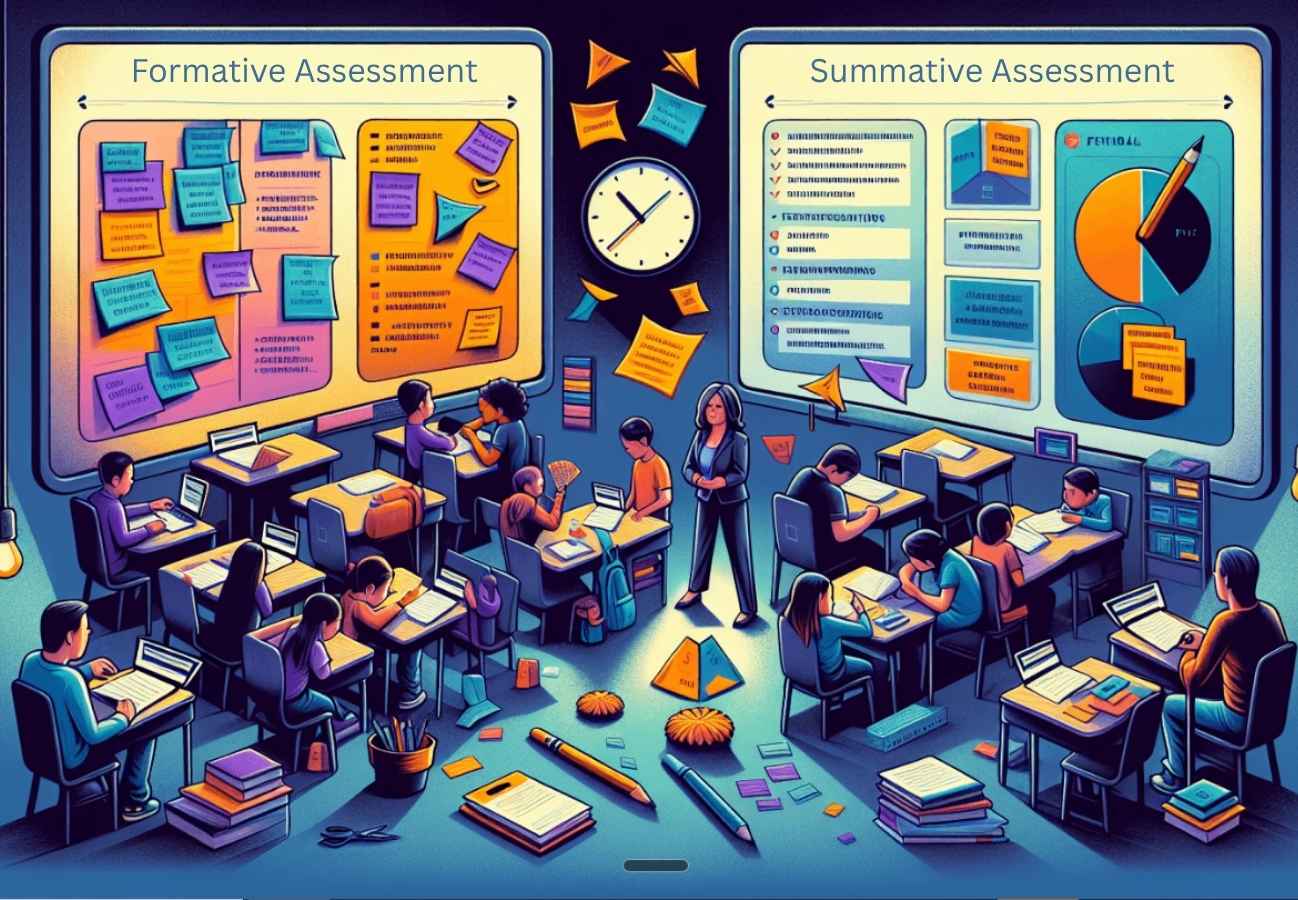What Are Formative Assessment Tools?
Formative assessment tools are digital and analog resources that help teachers gather real-time feedback about student learning during instruction. These best tools for teachers enable educators to adjust their teaching strategies immediately, rather than waiting until the end of a unit or semester. Unlike summative assessments that evaluate learning after instruction ends, formative assessment tools provide ongoing insights into student understanding while learning happens.
Research from the Assessment Reform Group shows that effective formative assessment can accelerate student learning by up to 70%. The key lies in choosing tools that seamlessly integrate into daily classroom routines without overwhelming teachers or students.
Compare with summative assessments: Formative vs Summative Assessment
Why Modern Teachers Need Digital Assessment Solutions
Traditional paper-based assessments often create barriers between teachers and timely student feedback. Digital formative assessment tools bridge this gap by providing instant data collection and analysis capabilities that transform how educators understand student progress.
Today's classrooms demand flexibility and responsiveness. Students learn at different paces and through various modalities. The best tools for teachers accommodate these differences while providing actionable insights that inform instructional decisions immediately.
Consider the difference between distributing paper exit tickets and using a digital polling tool. Paper tickets require collection, reading, and manual analysis. Digital tools provide instant visual feedback, allowing teachers to adjust the next day's lesson plan before students leave the classroom.
Essential Categories of Formative Assessment Tools
Real-Time Polling and Response Systems
Interactive polling tools capture student thinking instantly during lessons. These platforms allow teachers to pose questions and receive immediate feedback from every student, not just the vocal few who typically raise their hands.
Popular options include Kahoot for gamified responses, Poll Everywhere for sophisticated question types, and Mentimeter for anonymous feedback. Each tool serves different classroom dynamics and learning objectives.
Digital Exit Tickets and Check-In Tools
Exit tickets have evolved beyond paper slips. Digital versions provide structured ways for students to reflect on their learning while giving teachers organized data about class-wide understanding patterns.
Tools like Google Forms, Padlet, and specialized platforms such as Plickers offer various approaches to capturing end-of-lesson insights. The key advantage lies in automatic data organization and trend identification.
Collaborative Learning Platforms
These tools enable teachers to observe student thinking processes through collaborative work. Platforms like Jamboard, Flipgrid, and Nearpod allow students to share ideas while teachers monitor understanding in real-time.
The assessment value comes from observing student interactions, misconceptions, and peer explanations rather than formal testing scenarios.
Top-Rated Formative Assessment Tools for K-12 Educators
New and useful tools keep coming out, so the list below is not exhaustive. LearnButWhy has no commercial affiliation with any of the products listed.
Kahoot: Gamified Learning Assessment
Kahoot transforms assessment into engaging game experiences. Students respond to questions using their devices while competing in a fun, low-stakes environment that reveals learning gaps without anxiety.
Teachers can create custom quizzes or access thousands of pre-made assessments across all subject areas. The platform provides detailed analytics about individual and class performance patterns.
Padlet: Visual Learning Walls
Padlet creates digital bulletin boards where students post responses, images, or videos. Teachers can observe student thinking processes and identify misconceptions through these collaborative spaces.
The tool works particularly well for brainstorming sessions, vocabulary building, and project-based learning assessments where traditional quizzes fall short.
Flipgrid: Video Response Platform
Flipgrid enables students to record video responses to teacher prompts. This format captures nuanced understanding that written responses might miss, especially for verbal processors or English language learners.
Teachers can assess speaking skills, conceptual understanding, and student confidence levels through these authentic video interactions.
Nearpod: Interactive Lesson Integration
Nearpod embeds assessment directly into lesson delivery. Students participate in interactive slides, virtual reality experiences, and collaborative activities while teachers collect formative data seamlessly.
The platform combines content delivery with assessment, making evaluation feel natural rather than intrusive to the learning process.
Implementation Strategies for Maximum Impact
Start Small and Build Gradually
Successful integration begins with selecting one tool that addresses your most pressing assessment need. Master its features before adding additional platforms to avoid overwhelming yourself and students.
Consider your classroom technology access, student comfort levels, and your own learning curve when choosing initial tools.
Align Tools with Learning Objectives
The best tools for teachers match specific learning goals rather than impressive features. A simple Google Form might serve your needs better than a complex platform if your objective is straightforward feedback collection.
Match tool capabilities to assessment purposes: use polling for quick comprehension checks, collaborative platforms for peer learning assessment, and video tools for communication skill evaluation.
Explore Teaching Strategies and Learning Theories to identify the right objectives for your teaching practice.
Establish Clear Expectations and Routines
Students need explicit instruction about how to use assessment tools effectively. Create classroom norms around device use, response expectations, and digital citizenship within assessment contexts.
Consistent routines help students focus on learning rather than technology logistics, making assessment data more reliable and meaningful.
Addressing Common Implementation Challenges
Technology Access and Equity Concerns
Not all students have reliable device access or internet connectivity. Successful teachers prepare analog alternatives and ensure digital tools enhance rather than replace fundamental assessment practices.
Consider hybrid approaches that allow both digital and paper responses, ensuring every student can participate meaningfully in formative assessment activities.
Data Privacy and Student Safety
Educational technology requires careful attention to student privacy rights and data security. Review your district's approved tool lists and privacy policies before implementing new platforms.
Teach students about appropriate online behavior and help them understand how their learning data supports their educational growth.
Explore our guide on safe use of AI in education: Ensuring AI Safety
Avoiding Assessment Fatigue
Too much assessment, even formative assessment, can overwhelm students and reduce the quality of their responses. Balance formal assessment tools with informal observation and conversation.
Use assessment tools strategically rather than constantly, focusing on moments when feedback will most impact learning outcomes.
Measuring Success and Refining Practice
Effective formative assessment tool use requires ongoing reflection and adjustment. Monitor student engagement levels, response quality, and your own ability to act on the feedback you collect.
The most sophisticated tool becomes ineffective if teachers cannot translate its data into instructional improvements. Focus on tools that provide actionable insights you can realistically implement.
Student voice matters in this process. Ask learners about their experiences with different assessment formats and adjust your approach based on their feedback about what helps them learn best.
Future Trends in Formative Assessment Technology
Artificial intelligence increasingly supports personalized assessment experiences, providing adaptive questioning and automated feedback that supplements teacher insights. However, human judgment remains essential for interpreting student needs and designing responsive instruction.
Integration between assessment tools and learning management systems continues improving, creating more seamless data flow and reducing administrative burden on teachers.
The most promising developments focus on making assessment invisible to students while providing teachers with rich, actionable data about learning in progress. This approach maintains the authentic learning environment while supporting evidence-based instruction.









